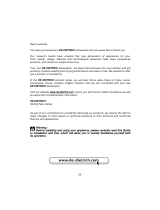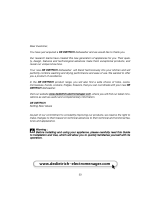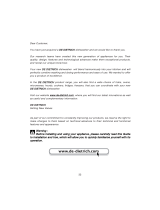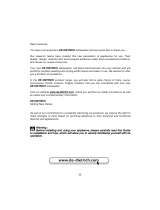Page is loading ...

EN INSTRUCTIONS FOR USE
Dishwasher

32
-
Dear Customer,
You have just acquired a
DE DIETRICH
dishwasher and we would like to thank you.
Our research teams have created this new generation of appliances for you. Their
quality, design, features and technological advances make them exceptional products,
and reveal our unique know-how.
Your new
DE DIETRICH
dishwasher will blend harmoniously into your kitchen and will
perfectly combine washing and drying performance and ease of use. We wanted to offer
you a product of excellence.
In the
DE DIETRICH
product range, you will also find a wide choice of hobs, ovens,
microwaves, hoods, cookers, fridges, freezers, that you can coordinate with your new
DE DIETRICH
dishwasher.
Visit our website
www.de-dietrich.com
, where you will find our latest innovations as well
as useful and complementary information.
DE DIETRICH
Setting New Values
As part of our commitment to constantly improving our products, we reserve the right
to make changes to them based on technical advances to their technical and functional
features and appearance.
Warning :
Before installing and using your appliance, please carefully read this Guide
to Installat
i
ion and Use, which will allow you to quickly familiarise yourself with
its operation.

33
CONTENTS
EN
1 / FOR THE USER’S ATTENTION
• Safety instructions ______________________________________ 34
• Environmental protection ________________________________ 35
• Economical, environmentally friendly washing ________________ 35
2 / DESCRIPTION OF YOUR APPLIANCE
• General presentation of the dishwasher ____________________ 36
• Control panel __________________________________________ 37
3 / INFORMATION ____________________________________________ 38
4 / WHAT TO DO BEFORE FIRST USING THE MACHINE
• Measure the water hardness and select the type of detergent __ 39
• Hardness table__________________________________________ 39
5 / WATER SOFTENER ADJUSTMENTS __________________________ 40
6 / ADJUSTING THE SETTINGS
•“SET” setting __________________________________________ 41
•“4/1” setting ____________________________________________ 41
7 / LOADING THE DETERGENT PRODUCTS ______________________ 42
8 / LOADING THE REGENERATING SALT ________________________ 43
9 / LOADING THE RINSING PRODUCT ____________________________ 44
10 / YOUR DISHWASHER’S EQUIPMENT
• The lower basket ________________________________________ 45
• The upper basket ________________________________________ 46
• The cutlery basket ______________________________________ 47
11 / WASHING PROGRAMMES __________________________________ 48
12 / PROGRAMMING __________________________________________ 50
13 / CLEANING YOUR APPLIANCE
• Cleaning the waste filters ________________________________ 52
14 / YOUR DISHWASHER’S SAFETY SYSTEMS ____________________ 54
15 / IF OPERATING ABNORMALITIES OCCUR ____________________ 55
16 /
AFTER-SALES SERVICE ____________________________________ 60
17 / INDICATIONS FOR THE TESTING LABORATORIES ____________ 62

34
EN
1 / FOR THE USER’S ATTENTION
Important :
Keep this user’s manual with your appliance. If the appliance is sold or transferred to
someone else, ensure that the manual is with it. Please take note of these instructions before
installing and using your appliance. They have been drawn up for your own and other
people’s safety.
• SAFETY INSTRUCTIONS
• Installation
— When you receive your appliance, unpack it or have it unpacked immediately. Check that it has
not suffered any damage during transport. Express any reservations in writing on the delivery note,
of which you keep a copy. Never connect up a damaged machine. If your appliance is damaged,
please contact your dealer.
— Before proceeding to connect up your machine, please refer to the instructions in your
Installation Guide.
— Your dishwasher must be kept disconnected from the mains supply throughout the whole of the
installation process.
— The electrical connection details on your appliance’s description plate must comply with those
for the mains supply.
— The socket must still be accessible once your appliance has been installed.
— Do not alter or attempt to alter the appliance’s characteristics. This could put you at risk.
— If your installation has to be altered, only entrust the electrical and plumbing work to a qualified
electrician or plumber respectively.
— Your appliance is designed for normal domestic use. Do not use it for industrial or commercial
purposes or for any other purpose than that for which it has been designed.
— Your appliance is designed to be used for household and similar applications such as:
• staff kitchenettes in shops, offices and other professional environments,
• farmhouses,
• use by guests at hotels, motels and other residential-type facilities,
• bed and breakfast type facilities.
— The dishwasher’s walls must not be pierced under any circumstances.
• Children’s safety
— This appliance is not intended for use by young children or infirm persons unless they have been
adequately supervised by a responsible person to ensure that they can use the appliance safely.
— This appliance must only be used by adults. Ensure that children do not touch it and do not use
it as a toy. Ensure that they do not operate the appliance’s controls.
— Keep young children away from the appliance when it is operating.
— Detergents contain irritant and abrasive substances. These products can have caustic effects on
the eyes, the mouth or the throat. They can be extremely dangerous if ingested. Avoid any contact
with the skin and the eyes. Ensure that the appliance’s detergent container is empty at the end of
the washing cycle.
— Place detergents out of children’s reach and do not put any detergent in the machine until just
before you start the washing programme.
— The water in your dishwasher is not drinking water; this is why children must not go near the
appliance when its door is open.
— Do not allow children to play with or sit on the door when it is open, as the dishwasher could
overturn.
— Once you have unpacked your appliance, place the packaging out of children’s reach.
— Keep all the packaging materials (e.g. plastic bags, polystyrene, etc.) out of children’s reach
because they can be dangerous for children (ie. risk of suffocation).

35
EN
1 / FOR THE USER’S ATTENTION
• Use
— This appliance is not intended for use by persons (including children) with reduced physical,
sensory or mental capabilities, or lack of experience and knowledge, unless they have been given
supervision or instruction concerning use of the appliance by a person responsible for their
safety.
— When machine is running, do not open door. This may provoke steam leakage or splattering of
water.
— Only use products specially designed for your dishwasher (water softening salt, detergent and
rinsing products).
— As far as possible, avoid opening the dishwasher’s door when it is operating, and in particular
during the heating phases, because scalding steam may escape or you may be splashed with hot
water. The machine is fitted
with a safety system that immediately blocks the dishwasher’s operation if the door is opened.
— Never use chemical solvents in your appliance because these could cause an explosion.
— Always close your appliance’s door after loading or removing your items.
— Do not lean or sit on your appliance’s door when it is open.
— You are strongly advised to disconnect the machine after use and turn off the water supply.
— Unplug your machine before carrying out any technical work on it.
— Avoid placing your machine immediately next to a cooking or heating appliance to prevent any
risk of heat damage;
— Do not place any items in your machine, which are not certified as dishwasher safe.
— If you have removed an item before the end of the washing programme, it is important to rinse it
carefully to remove any residual washing products.
— If your appliance breaks down, never attempt to repair it yourself. Any repairs made by
non-qualified personnel can cause significant damage or lack of control.
— The machine complies with applicable safety regulations. Any repairs should be carried out by
qualified technicians. Repairs or changes that do not conform may be dangerous for the users.
In case of replacement, only use original parts.
— If the machine malfunctions due to other causes than those mentioned in this booklet, disconnect
the machine (remove the plug) or break the circuit concerned and contact after-sales service.
•
ENVIRONMENTAL PROTECTION
This appliance’s packaging material is recyclable. Help recycle it and protect the environment by
dropping it off in the municipal receptacles provided for this purpose.
Your appliance also contains a great amount of recyclable material. It is marked with this
label to indicate that in countries that are a members of the European Union the used
appliances should not be mixed with other waste. This way, the appliance recycling
organised by your manufacturer will be done under the best possible conditions, in
compliance with European Directive 2002/96/EC on Waste Electrical and Electronic
Equipment. Contact your town hall or your retailer for the used appliance collection points
closest to your home.
We thank you doing your part to protect the environment.
• ECONOMICAL, ENVIRONMENTALLY FRIENDLY WASHING
— Remove any food residue from your crockery (bones, pips, etc.)
— Do not pre-wash your items by hand (useless waste of water).
— Utilise your dishwasher’s capabilities to the full for an economical, environmentally friendly wash.
— Always select a washing programme suitable for the crockery type and how dirty they are.
— Avoid overdosing with detergent, regenerating salt and rinsing liquid. Follow the
recommendations in this guide (pages 39-40-41) and the instructions on the product packs.
— Ensure that the water softener is correctly set (see page 40).

36
EN
2 / DESCRIPTION OF YOUR APPLIANCE
• GENERAL PRESENTATION OF THE DISHWASHER
Advice :
This user’s guide is applicable to several models. There may be some slight differences in
the details and the equipment between your appliance and the descriptions provided here.
Upper basket
Wash product dispenser
Anti-block guide wire
Cutlery basket
Lower basket
Lower sprinkler arm
Salt compartment
Waste filter
Main filter
Rinse aid dispenser
Reference plate (Ref. S.A.V.)
Control panel
L
K
J
I
H
G
F
E
D
C
B
A
Fig. 01
A
B
C
F
G
H
I
J
K
E
D
L

37
EN
2 / DESCRIPTION OF YOUR APPLIANCE
• CONTROL PANEL (SOME MODELS ONLY)
On/ Off :
Press this button to start up the dishwasher.
Selection buttons :
For choosing the programme (see page 50).
For enabling multi-function product
adjustment (see page 41).
Set, Delayed end
:
Changing the settings (see page 40 and 41).
Adjusting the programme end time (see
page 50).
Programme selected indicator
:
High brightness : this indicates the
programme has been selected.
Display :
This shows the current time, the programme
end time, the remaining programme time and
the setting adjustments.
Pilot lights :
Salt :
On: indicates the salt compartment is empty or
almost empty.
Rinse aid :
On: indicates the rinse aid compartment is
empty or almost empty.
Multi-function products :
On: this indicates the “4/1” function is
activated (see page 39 and 41). The
programmes are automatically adapted to
multi-function products.
START :
Press this button to start up the programme.
In case of error, hold down this button for a
few seconds to cancel a selection or a
programme that is already running.
G
F
E
D
C
B
A
For power saving purposes, this dishwasher automatically goes onto standby if it has not been
activated for a certain period (except in time delay mode).
All the pilot lights will switch off except the “START” button light and the light for the programme
in progress, which will flash.
To exit standby mode, simply press the “START” button. The dishwasher will then go into its
previous status.
-------------------------------------------------------------- or --------------------------------------------------------------
F
Fig. 02a
A
E
C
G
B
D
Observations :
A short beep confirms the button has been pressed (except the “On/Off” button).

38
EN
3 / INFORMATION
•
There are so many different types
of product. How can I choose the
best one ?
For impeccably clean dishes,
you should use a combination
of classic products :
①
Wash product
for perfectly clean
dishes (powder or liquid detergent or
standard tablets).
②
Dishwasher salt
for correct
functioning of your dishwasher’s water
softener.
③
Rinse aid
to help the dishes dry
and eliminate drop marks
.
Important :
For your dishwasher to provide
excellent washing and drying results and
leave no marks, you must correctly adjust it
using the water softening system, which
works with dishwasher salt.
•
Scale,
when rainwater filters into the soil,
it takes in mineral salts, some of which are
found in solid form and are commonly
referred to as scale. Scale in the water
reduces the detergent’s washing efficiency,
causes deposits to form on the dishwasher
itself and leaves white marks on the dishes.
The more scale there is in the water, the “harder”
the water is.
You should use products suited to the water
hardness in your particular area.
Important :
Never use normal washing-up liquid.
For ease of use and in certain water
hardness conditions only (< 25°F),
multi-purpose products
can make the
use of regenerating salt and rinsing liquid
unnecessary.
• “Two-in-one” tablets
contain
detergents and rinsing liquid or an
agent serving the function of the salt.
• “Three-in-one” tablets
contain
detergents and rinsing liquid as well as
an agent serving the function of the salt.
• “Four-in-one” “Five-in-one”
tablets...
also contain additives to
prevent “wear” to glasses (i.e. to stop
them clouding), risk of corrosion and
discolouring of stainless steel.
Important :
Follow the instructions in the user’s
manual and the recommendations on the
multi-purpose detergent’s pack.
NB :
If in any doubt, please contact the
detergent’s manufacturer if the items are
very wet at the end of the programme or if
chalky deposits appear.

39
EN
4 / ACTIONS BEFORE FIRST USE
In one simple action, you can test the your water’s lime content using the testing strip supplied with
your dishwasher. Alternatively, contact your local water utility to ascertain your water’s hardness.
— Let the water run from the tap for a few moments.
— Fill a glass with water.
— Take the test strip from its holder and immerse it for 3 seconds.
— Wait 1 minute, shake it and look at the colours to ascertain your water’s hardness.
• MEASURE THE WATER HARDNESS AND SELECT THE TYPE OF
DETERGENT: TRADITIONAL OR MULTI-PURPOSE
• HARDNESS TABLE
Possible use of
traditional products
➊
Use only of
traditional products
➊
multi-function products ➋
R
+
or or
or
+
R
+
or or
+
➋
➊
Test strip
Hardness
0-10°F
0-1mmol/l
0 - 5,6 °dH
10-18°F
1-1,8mmol/l
5,6 - 10 °dH
18-25°F
1,8-2,5mmol/l
10 - 14 °dH
25-40°F
2,5-4mmol/l
14 - 22,4 °dH
40-55°F
4-5,5mmol/l
22,4 - 30,8 °dH
55-70°F
5,5-7,0mmol/l
30,8 - 39,2 °dH
> 70°F
>
7,0mmol/l
> 39,2
°dH
Water
Soft
Slightly hard Slightly hard
Hard Hard Hard Very hard
Water softe-
ning and use
of salt
Optional
Essential if
using traditional
products
Essential if
using traditional
products
Mandatory Mandatory Mandatory Mandatory
➊
Traditional products: P
:
P
owder detergent or
L
:
L
iquid detergent or single tablet
+
S
: Regenerating
S
alt +
R
:
R
insing product
➋
Multi-function products:
Multi-function tablets

40
EN
5 / WATER SOFTENER ADJUSMENTS
Fig. 02b
Important :
IIt is essential to correctly adjust the water softener according to the hardness of the water in
your area.
-If the adjustment is too low, scale may be left on the dishes.
-If the adjustment is too high, there is a risk of glasses becoming cloudy.
If you move house, adjust the water softener again.
• Proceed as follows to adjust the water softener to the control table :
—
This adjustment is to be done at the “SET” Adjustment stages (see page 41).
— To change the adjustment between
H0
and
H6
, according to the water hardness (see the table
below), briefly press the up or down buttons
successively.
The display will indicate the adjustment
.
— Make sure you validate the adjustment by briefly pressing “Start/C” twice (to exit the “SET”
Adjustment menu, see page 11).
— To use multi-function tablets you must select adjustment H0 or H1 or H2, according to the water
hardness. < 25ºF. Make the adjustment as indicated on page 41.
Important :
Adjustment H0 disables the salt refill indicator light.
Hardness
0-10°F
0-1mmol/l
0 - 5,6 °dH
10-18°F
1-1,8mmol/l
5,6 - 10 °dH
18-25°F
1,8-2,5mmol/l
10 - 14 °dH
25-40°F
2,5-4mmol/l
14 - 22,4 °dH
40-55°F
4-5,5mmol/l
22,4 - 30,8 °dH
55-70°F
5,5-7,0mmol/l
30,8 - 39,2 °dH
> 70°F
>
7,0mmol/l
> 39,2
°dH
Adjust
ments
HIH0 H2 H3 H4 H5 H6

41
EN
6 / ADJUSTING THE SETTINGS
The adjustments will be stored in the memory after validating the last setting.
If you cancel (by holding down the “START” button) or switch off the appliance during
adjustment, the setting changes will not be registered
.
•
Hold down the “Set” button once to access the adjustment menu.
•
Adjust the settings using the programme selection buttons .
•
Briefly press the “Start” button once to go on to the next setting.
> Adjusting the water softener
Adjust this to the corresponding degree for the water hardness measured, from
H0
to
H6
(see page 40).
Press “Start” to go on to adjustment of the next setting.
• “SET” SETTING
> End of programme beep
Adjust to to activate this function, or if you do not require an
end-of-programme beep.
Press “Start” to save the settings
> Multi-function products
Select this function if you are using multi-function products.
Reminder : For optimum product efficiency, it is important to correctly adjust the water softener
(see page 40). If it is adjusted to H3 or higher, this function cannot be enabled.
To enable or disable this function, before selecting the programme hold down the selection button
until the pilot light switches on or off.
(pilot light on) function enabled;
(pilot light off) function disabled.
Enabling this function cancels the dishwasher salt and rinse aid level display.
• “4/1” SETTING
> Adjusting the clock (hours)
When the hour is flashing, press either of the selection buttons until the desired
hour is reached.
Press
“Start”
to go on to adjustment of the next setting.
> Adjusting the clock (minutes)
Follow the same procedure: press either of the selection buttons until the
desired minutes are reached.
Press
“Start”
to go on to adjustment of the next setting.

42
EN
7 / LOADING THE DETERGENT PRODUCTS
Important :
Keep these products out of the reach of children and away from damp (the protective film
on the tablets might be water-soluble).
Only use products specially designed for dishwashers.
Fig. 03 Fig. 04 Fig. 05
To make loading the detergent easier, the distributor is located on the front of the upper basket.
It is compatible with all the products recommended for your dishwasher.
• Powders or liquids (Fig 03)
-- Pull out the dispenser drawer
-- Fill at least up to the minimum mark for slightly dirty crockery and to the maximum mark for dirty
crockery. If the crockery is very dirty and for programmes with a pre-wash we recommend that you
add 5g of detergent (a dessert spoonful) into your dishwasher’s tub in accordance with the
programmes table.
-- Close the distributor.
• “Multi-purpose ” or Traditional tablets (Fig 04 and 05)
-- Place the tablet in the external compartment
(Fig 04),
or, for optimum operation,
--
pull out the distributor’s drawer and lay the tablet there
.
(Fig 05).
-- Close the distributor.
• Loading the detergent products. (Fig. 03-04-05)

43
EN
8 /
LOADING THE REGENERATING SALT
EAU
SEL
A
B
C
Fig. 06
Important :
Use special salt for dishwashers. Never use
table salt or cooking salt as this could damage
the appliance
.
Unscrew and remove the compartment
cap.
Fill the compartment with special
dishwasher salt. Use the funnel supplied with
the dishwasher.
Firmly screw the cap back on.
The first time you fill the compartment
with salt, fill it up to the top with water.
• Determining the
regenerating
salt
level :
A scale on the display indicates the fill level.
full
almost
full
empty
(flashing)
C
B
A
Important :
If the salt overflows from the dispenser, remove the excess salt crystals to prevent risk of the
tank rusting and run a Soak programme or, failing this, a short programme (see page 48-49) with no
load in the dishwasher.
Firmly screw the compartment cap back on.
•
Loading the regenerating salt
. (Fig. 06)

44
9 /
LOADING THE RINSING PRODUCT
EN
Adjustment lever
Fig. 07
1
2
3
1
2
3
A
B
C
Important :
Use a special dishwasher rinse aid product
to improve drying and prevent filming.
Unscrew and remove the compartment
cap.
Before starting up the dishwasher, fill the
compartment with rinse aid up to the
adjustment lever.
Firmly screw the cap back on.
The default adjustment is 2.
If drying is inefficient or marks are leftthe
glasses (after having run several cycles),
you may increase the dosage by setting the
adjustment to 3 ;
Tip :
Setting the adjustment to 1 reduces rinse aid
consumption and may be sufficient for your
needs.
• Determining the rinse aid product
level :
This pilot light comes on when rinse aid needs
to be added.
A scale on the display indicates the fill level.
full
almost
full
empty
(flashing)
C
B
A
Important :
If the rinse aid overflows onto the door on refilling, sponge off the excess to prevent foam
from forming.
•
Loading the rinsing product
. (Fig. 07)

45
EN
10 / YOUR DISHWASHER’S EQUIPMENT
Fig. 09
Fig. 08
Arrange your items so that the water can
circulate freely and spray over all the utensils.
Place large diameter dishes and pans at
the sides.
Do not intersperse, jam together or
superimpose flat plates and concave dishes
(Fig. 08).
The folding spikes make it easier to arrange
your large dishes (Fig. 09) (depending on
the model).
Advice :
When you re-insert the lower basket,
ensure that nothing catches on the upper
basket’s gauge wire to avoid blocking the
rotor.
Unloading your items
First of all empty the lower basket to avoid
drips from the upper basket falling onto the
lower basket.
• THE LOWER BASKET
Very important :
Items not suitable for washing in a dishwasher
- Wooden cutting boards,
- Stainless steel utensils or plastic utensils that are not heat-resistant,
- Copper or pewter items,
- Glued crockery and cutlery,
- Cutlery with wooden, horn or mother-of-pearl handles,
- Antique or hand-painted porcelain.
When purchasing crockery, glasses or cutlery, ensure that it is dishwasher-safe.
Washing capacity : 13 standard place settings

46
EN
10 / YOUR DISHWASHER’S EQUIPMENT
Fig. 11
• THE UPPER BASKET
This basket is particularly designed to take
glasses, cups, ramekins, small salad bowls,
bowls and saucers.
Arrange your items methodically (arranging
glasses, cups or bowls together) to save on
space (Fig. 10).
You can also arrange cups, ladles, etc. on the
folding cup racks.
Advice:
Position the cavities of glasses, cups
or bowls facing downwards.
• Adjusting the height of the upper
basket
For large dishes to be loaded in the lower
basket, the upper basket must be set the to
high position. This can be done with the
basket fully loaded (Fig. 11)
①
Setting in HIGH POSITION :
Gently raise your basket on each side until it
engages.
②
Setting in LOW POSITION :
Raise your basket completely on both sides
to unlock it and then lower it to the low
position.
Important :
Check that the two slides are set to the same
height and the basket is horizontal.
Fig. 10
Cutlery basket

47
EN
10 / YOUR DISHWASHER’S EQUIPMENT
Fig. 13
Fig. 12
• THE CUTLERY BASKET
The cutlery basket slides along runners for
flexible loading.
You can place it in any part of the lower
basket you wish, to change the loading
arrangement according to the items in the
load (Fig 12.).
If the cutlery or dishes are too large and do
not fit, adjust the height of the upper basket
(if it is adjustable on your model of
dishwasher)
.
Movable grills are available for if you wish to
load your cutlery in an orderly manner
(Fig. 13).
For optimum washing and drying, use these
separation grills partially or totally.
Point the handles on the cutlery downwards.
Important :
For safety reasons, we recommend
that you place knives with pointed ends with
the point facing downwards in the cutlery
basket (to avoid the risk of an accident).
Long-bladed knives and other sharp kitchen
utensils must be placed flat in the upper bas-
ket.
Avoid washing cutlery with horn handles in
your dishwasher.
Separate silverware from other metals using
the separation grill.

48
These values refer:
- to normal usage conditions with separated products (detergents, salt, rinsing product).
- only to multifunction product usage conditions
They may vary depending on the load, the water temperature, the softener setting, the presence of
rinsing product and the supply voltage.
EN
11 /
WASHING PROGRAMMES
• PROGRAMME CHART
air drying
Medium dirty
an average
amount of food
residue and
grease.
This is the most
economical
programme as
regards
water
and
energy
saving
hot rinse
Mixed
rinse
wash 50°C
air drying
Mixed
Intelligent
Control
System +
Automatic
detection
of amount
of dirt.
Optimises results,
prioritising
energy saving.
hot rinse
rinse
wash 50-65°C
prewash
95
- 125
15
-17
1,25
- 1,40
215
9
1,05
Type of crockery :
porcelain, pans,
cutlery, glasses
etc
...
Amount,
type and
state of food
residues.
Programmes
Programme
sequence.
for guidance
Duration (
m
min)
Water (l)
Energy (kWh)
air drying
Resistant
Very dirty
Very dirty dinner
plates and pans,
baked-on stains,
grease, frying
residues, harde-
ned cheese,
sauce, etc.
hot rinse
rinse
wash 70°C
hot prewash
130
- 150
17
- 19
1,7
- 1,8
*
Mixed
air drying
hot rinse
rinse
wash 45°C
Medium dirt
i.e. an average
amount of food
residue and
grease.
This is the
quietest
programme, it
saves energy
and is ideal for
washing the
dishes at night.
315
- 320
10
- 12
1,05
- 1,2

49
EN
11 /
WASHING PROGRAMMES
Mixed
Very short cycle
(no detergent)
to rinse and keep
the dishes wet
before washing
the following day
or the day after
cold prewash
Mixed
air drying
hot rinse
rinse
wash 60 °C
Short wash,
60 minutes
specially suited
to day-to-day
dishes, ordinary
dirt, slightly dirty
60
14 -
16
1,3 -
1,4
Delicate
Very short wash,
30 minutes
specially suited to
delicate loads
of day-to-day dis-
hes, slightly dirty,
dirt not dried on,
no excessive
grease.
hot rinse
rinse
wash 45°C
30
11
0,95
15
4,5
0,02
air drying
Mixed
Special
cycle for
sanitising
day-to-day
dishes.
hot rinse
rinse
wash 70°C
hot prewash
100
- 120
17
- 19
1,6
- 1,7
No load
Specific
maintenance
programme
The dishwasher
must be
completely
emptied and any
large residues
removed from
the filter.
Removes grease
and scale from the
dishwasher tank,
keeping it working
efficiently and
prolonging its
lifetime.
For optimum
results, use
a specially des-
igned dishwasher
cleaning fluid
(if not, powder or a
tablet in the
product drawer).
90
11
0,9
1
This programme can be accessed by pres-
sing the button if the programme is on
high brightness display.
1
Recommended programme :
*
EN50242
“Off mode” : 0,5 W
“left-on mode” : 0,9 W

50
Important :
If your dishwasher has a front control panel, in order to prevent the buttons from being
pressed accidentally on opening or moving the door the programming can only be done with the
door closed.
EN
12 / PROGRAMMING
•
Immediate programme start
Choose the desired programme by pressing
either of the buttons.
The programme pilot light will come on (high
brightness).
The display shows the programme end time.
Validate your choice by pressing button . The
programme will start up.
The time will count down as the programme
advances. The display shows the time
remaining until the end of the programme.
When the programme finishes, the word
End
will appear on the display
.
Then Switching to
energy savings
(see page 37).
E
G
E
D
B
•
Starting up the appliance
Press button , lhe display will light up.
E
A
Advice:
Consult the Programmes table on the preceding pages to determine the programme you
need for the type of items, the quantity and the amount of food residue.
F
Fig. 14
A
E
C
G
B
D
Programme
end time
Programme time
remaining (min)
End of programme
/






